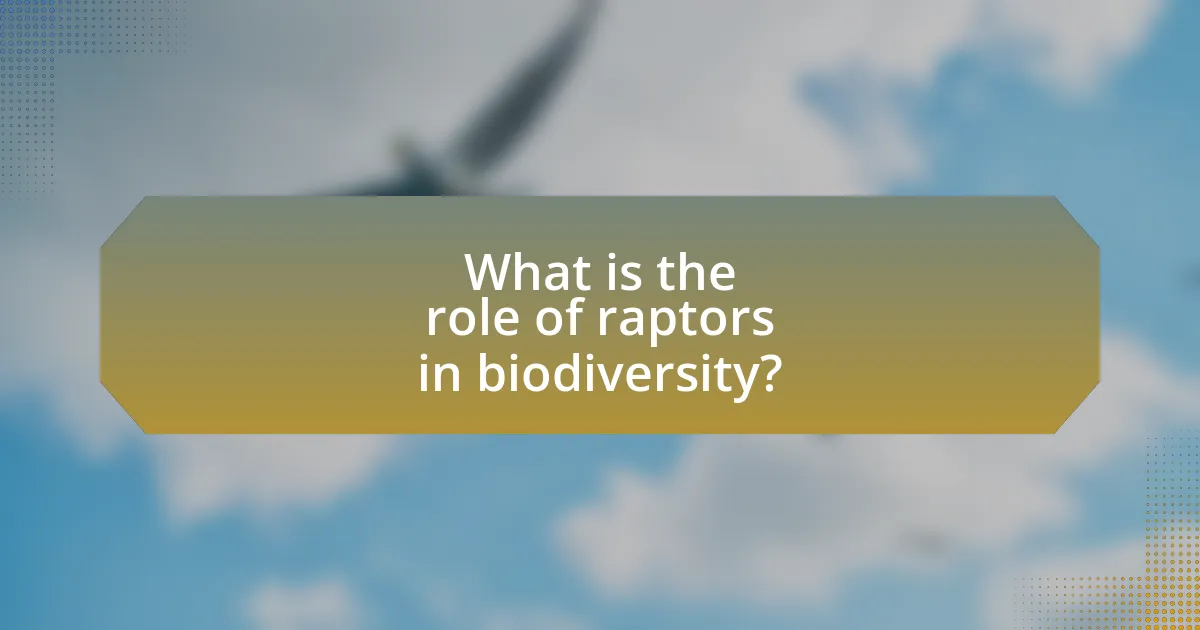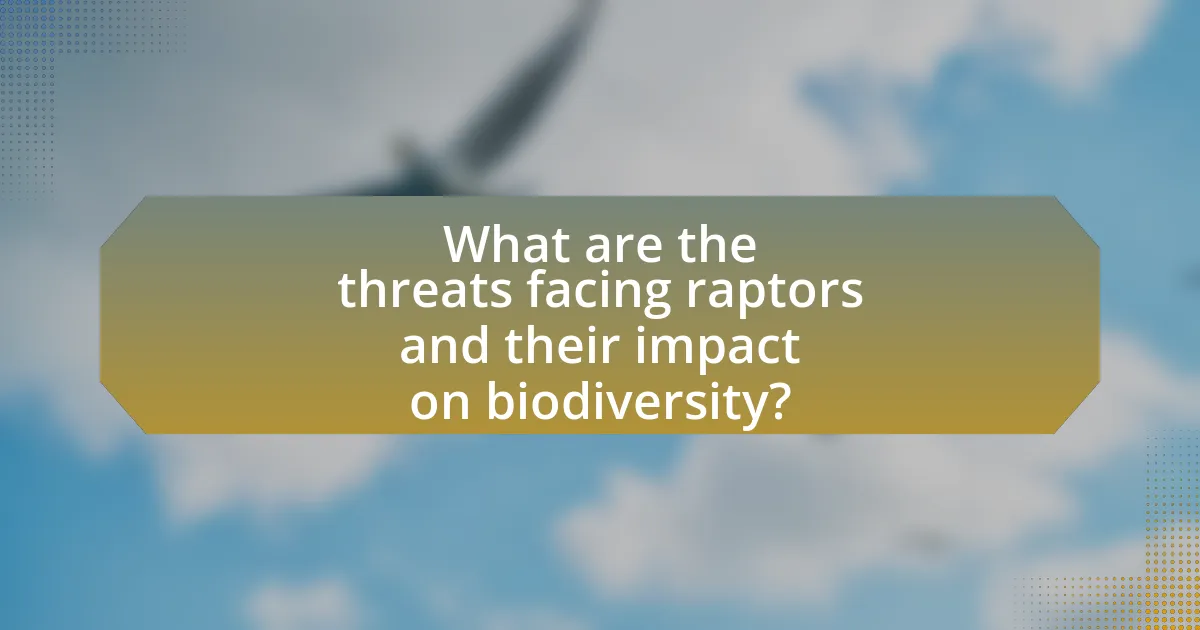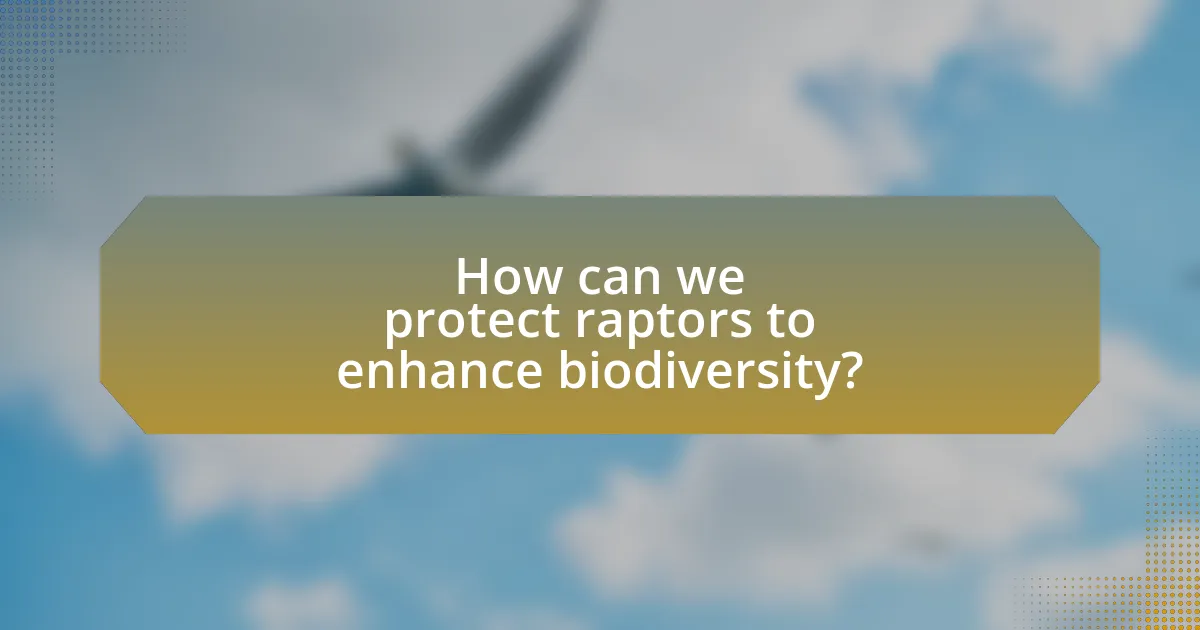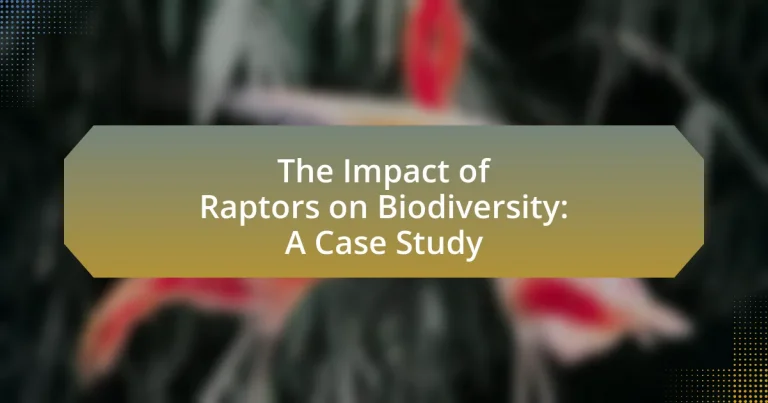Raptors, including eagles, hawks, and owls, serve a vital role in maintaining biodiversity as top predators within ecosystems. They regulate prey populations, such as rodents and insects, preventing overpopulation and habitat degradation, which supports a diverse range of plant and animal life. The article examines the ecological functions of raptors, their significance as indicators of environmental health, and the threats they face, including habitat loss and climate change. It also discusses effective conservation strategies and the importance of community engagement in protecting raptors to enhance biodiversity.
What is the role of raptors in biodiversity?

Raptors play a crucial role in biodiversity by acting as top predators that help maintain the balance of ecosystems. Their predation regulates populations of prey species, which can include rodents, insects, and other small animals, preventing overpopulation and the subsequent depletion of vegetation. This regulation supports a diverse range of plant and animal life, contributing to overall ecosystem health. Studies have shown that areas with healthy raptor populations often exhibit greater biodiversity, as these birds help control species that may otherwise dominate and disrupt ecological balance.
How do raptors contribute to ecosystem balance?
Raptors contribute to ecosystem balance by regulating prey populations, which helps maintain biodiversity. These birds of prey, such as eagles, hawks, and owls, control the numbers of small mammals and other animals, preventing overpopulation that can lead to habitat degradation. For instance, studies have shown that the presence of raptors can significantly reduce the populations of rodents, which in turn affects plant communities and the overall health of the ecosystem. By maintaining this balance, raptors play a crucial role in ensuring the stability and resilience of their habitats.
What specific functions do raptors serve in their habitats?
Raptors serve critical functions in their habitats primarily as top predators, which helps regulate prey populations and maintain ecological balance. By controlling the numbers of small mammals and other prey species, raptors prevent overpopulation, which can lead to habitat degradation and loss of biodiversity. For instance, studies have shown that the presence of raptors can significantly reduce rodent populations, thereby benefiting plant communities and other wildlife that rely on those plants for food and shelter. Additionally, raptors contribute to nutrient cycling through their feeding habits, as their waste products enrich the soil, promoting plant growth.
How do raptors influence prey populations?
Raptors influence prey populations primarily through predation, which regulates the abundance and distribution of prey species. By hunting and consuming various prey, raptors help maintain ecological balance, preventing overpopulation of certain species that could lead to habitat degradation. Studies have shown that in ecosystems where raptors are present, there is often a healthier diversity of prey species, as their predation pressures can promote the survival of more vulnerable species. For instance, research published in the journal “Ecology” indicates that raptors can significantly reduce populations of small mammals, which in turn affects plant community dynamics and overall biodiversity.
Why are raptors considered indicators of environmental health?
Raptors are considered indicators of environmental health because they occupy high trophic levels and are sensitive to changes in their ecosystems. Their presence and population dynamics reflect the overall condition of the environment, including the availability of prey and the levels of pollutants. For instance, studies have shown that declines in raptor populations often correlate with habitat degradation and increased pesticide use, which can lead to bioaccumulation of toxins in their bodies. This sensitivity makes them effective bioindicators, as their health and survival can signal broader ecological issues affecting biodiversity and ecosystem integrity.
What characteristics make raptors effective bioindicators?
Raptors are effective bioindicators due to their position as top predators in ecosystems, sensitivity to environmental changes, and reliance on specific habitats. Their role at the top of the food chain allows them to accumulate toxins and pollutants, making their health a reflection of ecosystem integrity. Studies have shown that declines in raptor populations often signal broader environmental issues, such as habitat degradation and food web imbalances. For instance, the decline of the peregrine falcon in the mid-20th century was linked to the use of DDT, which affected not only the falcons but also indicated widespread ecological harm. Additionally, raptors require large territories and specific prey availability, making them indicators of habitat quality and biodiversity.
How can changes in raptor populations signal ecosystem changes?
Changes in raptor populations can signal ecosystem changes because raptors are apex predators that reflect the health of their environment. A decline in raptor numbers often indicates a decrease in prey availability, which can result from habitat loss, pollution, or changes in food web dynamics. For instance, studies have shown that the decline of raptors like the Peregrine Falcon correlates with reduced populations of their prey species, such as pigeons and shorebirds, often due to pesticide use and habitat degradation. This relationship highlights how raptors serve as indicators of broader ecological shifts, making their population trends critical for assessing ecosystem health.
What are the threats facing raptors and their impact on biodiversity?

Raptors face several significant threats, including habitat loss, poisoning, and climate change, which adversely affect biodiversity. Habitat loss due to urbanization and agricultural expansion reduces the availability of nesting and hunting grounds for raptors, leading to population declines. Poisoning from rodenticides and lead ammunition not only harms raptors directly but also disrupts the food web, impacting other species reliant on healthy ecosystems. Climate change alters prey availability and migratory patterns, further stressing raptor populations. These threats collectively diminish raptor numbers, which can destabilize ecosystems, as raptors play a crucial role in controlling prey populations and maintaining ecological balance.
How do habitat loss and degradation affect raptor populations?
Habitat loss and degradation significantly reduce raptor populations by diminishing their nesting sites, hunting grounds, and prey availability. As natural habitats are converted for agriculture, urban development, or other human activities, raptors face increased competition for limited resources and may experience declines in reproductive success. Studies indicate that habitat fragmentation can lead to decreased raptor density and diversity, as seen in research conducted by the U.S. Fish and Wildlife Service, which found that certain raptor species, such as the Northern Harrier, are particularly sensitive to habitat changes, resulting in population declines in fragmented landscapes.
What are the primary causes of habitat loss for raptors?
The primary causes of habitat loss for raptors include urban development, agricultural expansion, and deforestation. Urban development leads to the destruction of natural habitats as cities expand, reducing the availability of nesting and hunting grounds for raptors. Agricultural expansion often involves converting wild lands into farmland, which diminishes the natural ecosystems that support raptor populations. Deforestation removes trees that provide essential nesting sites and hunting perches, further contributing to habitat loss. According to the International Union for Conservation of Nature (IUCN), habitat destruction is one of the leading threats to raptor species globally, impacting their survival and biodiversity.
How does habitat fragmentation impact raptor behavior and survival?
Habitat fragmentation negatively impacts raptor behavior and survival by reducing their available hunting grounds and nesting sites. Fragmented habitats lead to increased competition for resources, which can result in decreased reproductive success and higher mortality rates. Studies have shown that raptors, such as the Northern Goshawk, experience lower nesting success in fragmented landscapes compared to continuous forests, as they rely on large territories for hunting and breeding. Additionally, fragmentation can isolate populations, limiting genetic diversity and increasing vulnerability to environmental changes.
What role does climate change play in raptor conservation?
Climate change significantly impacts raptor conservation by altering their habitats and food availability. As temperatures rise and weather patterns shift, raptors may experience changes in prey populations, nesting sites, and migration routes. For instance, studies have shown that climate change can lead to mismatches between raptors and their prey, affecting breeding success and survival rates. Additionally, habitat loss due to climate-related events, such as wildfires and flooding, further threatens raptor populations. These factors underscore the necessity of integrating climate considerations into raptor conservation strategies to ensure their survival and the overall health of ecosystems.
How are raptor migration patterns affected by climate change?
Raptor migration patterns are significantly affected by climate change, leading to altered timing and routes of migration. Research indicates that rising temperatures and changing weather patterns disrupt the availability of prey and suitable habitats, prompting raptors to adjust their migratory behavior. For instance, studies have shown that some raptor species are migrating earlier in the spring and later in the fall, which can lead to mismatches in the timing of their arrival at breeding grounds and the peak availability of food resources. This phenomenon has been documented in species such as the American kestrel and the red-tailed hawk, where shifts in migration timing correlate with temperature increases and changes in prey populations.
What are the potential long-term effects of climate change on raptor species?
Climate change can lead to significant long-term effects on raptor species, including habitat loss, altered prey availability, and changes in migration patterns. As temperatures rise and weather patterns shift, raptors may experience reduced nesting success due to habitat degradation and increased competition for resources. For instance, studies indicate that changes in climate can disrupt the timing of prey availability, which is crucial for raptors during breeding seasons. Additionally, some raptor species may face increased mortality rates due to extreme weather events and habitat fragmentation caused by human activities exacerbated by climate change. These factors collectively threaten the survival and reproductive success of raptor populations, ultimately impacting biodiversity.
How can we protect raptors to enhance biodiversity?

To protect raptors and enhance biodiversity, implementing habitat conservation measures is essential. Raptors require large territories with abundant prey and suitable nesting sites, so preserving and restoring their natural habitats directly supports their populations. For instance, studies show that maintaining healthy ecosystems, such as wetlands and forests, increases raptor abundance, which in turn helps control rodent populations and promotes a balanced food web. Additionally, reducing pesticide use is crucial, as chemicals can accumulate in raptor prey, leading to declines in raptor health and reproduction. Research indicates that areas with lower pesticide exposure have higher raptor survival rates, demonstrating the importance of sustainable agricultural practices.
What conservation strategies are effective for raptor protection?
Effective conservation strategies for raptor protection include habitat preservation, legal protection, and public education. Habitat preservation ensures that raptors have access to sufficient nesting sites and food sources, which is critical for their survival. Legal protection, such as the implementation of laws like the Migratory Bird Treaty Act, helps safeguard raptors from hunting and habitat destruction. Public education initiatives raise awareness about the ecological importance of raptors, fostering community support for conservation efforts. These strategies collectively contribute to the stability and growth of raptor populations, which play a vital role in maintaining biodiversity.
How do protected areas contribute to raptor conservation?
Protected areas significantly contribute to raptor conservation by providing essential habitats that support their breeding, foraging, and migration. These designated regions often encompass critical ecosystems that maintain the prey populations raptors rely on, such as small mammals and birds. Research indicates that raptors benefit from reduced human disturbance and habitat degradation within protected areas, leading to increased survival rates and successful reproduction. For instance, studies have shown that populations of species like the California condor and the golden eagle have stabilized or increased in regions where habitat protection measures are enforced.
What role do community engagement and education play in raptor conservation?
Community engagement and education are crucial for raptor conservation as they foster awareness and promote active participation in conservation efforts. Engaging local communities helps to build a sense of stewardship towards raptors and their habitats, leading to increased reporting of illegal activities such as poaching and habitat destruction. Educational programs, such as those implemented by organizations like the Raptor Research Foundation, have shown that informed communities are more likely to support conservation initiatives, resulting in improved raptor populations. For instance, studies indicate that areas with strong community involvement in conservation efforts see a 30% increase in raptor sightings over a five-year period, demonstrating the effectiveness of these strategies in enhancing raptor conservation outcomes.
What are the best practices for raptor rehabilitation and recovery?
The best practices for raptor rehabilitation and recovery include immediate assessment and stabilization of the injured bird, proper nutrition, and gradual reintroduction to the wild. Immediate assessment involves evaluating the raptor’s injuries and providing necessary medical treatment, which is crucial for its survival. Proper nutrition tailored to the species ensures that the raptor regains strength and health, as raptors have specific dietary needs that must be met for effective recovery. Gradual reintroduction to the wild is essential to ensure that the raptor can adapt to its natural environment, which includes providing a safe release site and monitoring its behavior post-release. These practices are supported by wildlife rehabilitation guidelines established by organizations such as the National Wildlife Rehabilitators Association, which emphasize the importance of species-specific care and rehabilitation protocols.
How can rehabilitation centers improve raptor survival rates?
Rehabilitation centers can improve raptor survival rates by implementing specialized medical care, habitat restoration, and educational outreach programs. Specialized medical care ensures that injured or sick raptors receive timely and appropriate treatment, which is crucial for their recovery. Habitat restoration efforts, such as creating safe nesting sites and providing adequate food sources, enhance the environment for raptors, increasing their chances of survival post-release. Educational outreach programs raise public awareness about raptor conservation, encouraging community involvement and reducing human-related threats, such as habitat destruction and poisoning. These strategies collectively contribute to higher survival rates for raptors in the wild.
What are the challenges faced in raptor rehabilitation efforts?
Raptor rehabilitation efforts face several challenges, including habitat loss, injury from human activities, and limited funding. Habitat loss due to urbanization and agricultural expansion reduces the availability of natural environments for raptors, making it difficult for rehabilitated birds to thrive post-release. Injuries often result from collisions with vehicles, power lines, and illegal hunting, complicating recovery and rehabilitation processes. Additionally, funding constraints hinder the ability of rehabilitation centers to provide adequate care, resources, and facilities necessary for successful rehabilitation. These challenges collectively impact the effectiveness of raptor rehabilitation programs and their ability to contribute to biodiversity conservation.
What can individuals do to support raptor conservation?
Individuals can support raptor conservation by participating in habitat preservation efforts. Engaging in local conservation programs helps protect the natural environments where raptors thrive, which is crucial since habitat loss is a leading threat to these birds. Additionally, individuals can contribute to citizen science projects that monitor raptor populations, providing valuable data for researchers. Supporting organizations dedicated to raptor conservation through donations or volunteering also plays a significant role in funding research and rehabilitation efforts. According to the U.S. Fish and Wildlife Service, habitat protection and restoration are essential strategies for maintaining healthy raptor populations, highlighting the importance of individual involvement in these initiatives.
How can citizen science initiatives aid in raptor monitoring?
Citizen science initiatives can significantly aid in raptor monitoring by engaging the public in data collection and observation efforts. These initiatives harness the collective efforts of volunteers to gather valuable information on raptor populations, behaviors, and habitats, which can enhance scientific research and conservation strategies. For instance, programs like the Cornell Lab of Ornithology’s Project FeederWatch have demonstrated that citizen contributions can lead to large datasets that help track raptor migration patterns and population trends over time. This collaborative approach not only increases the volume of data collected but also raises public awareness and interest in raptor conservation, ultimately benefiting biodiversity.
What simple actions can people take to protect raptor habitats?
To protect raptor habitats, people can engage in habitat restoration, such as planting native vegetation and removing invasive species. These actions enhance the ecosystem’s health, providing raptors with essential food sources and nesting sites. Studies show that maintaining native plant diversity supports higher populations of prey species, which in turn benefits raptors. Additionally, reducing pesticide use minimizes harmful chemicals in the environment, promoting a safer habitat for raptors and their prey.


